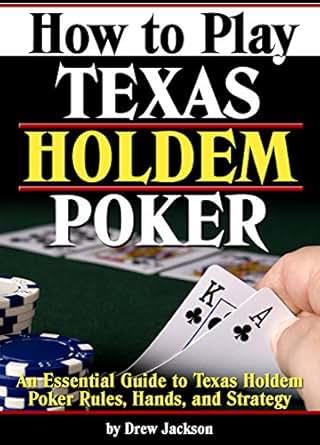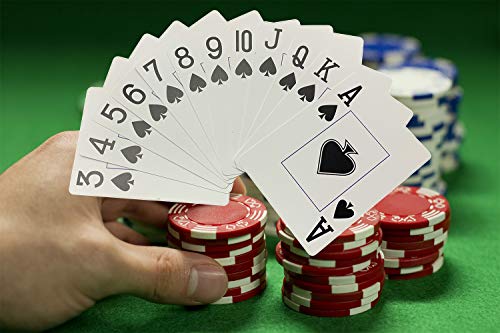Texas Holdem Poker Kartendeck
Hone your poker skills in this game of Poker Practice. Copag will spring back to their original shape, which is perfect for peaking games like Texas Hold’em. The integrity of Copag 100% plastic playing cards will never be compromised under regular gaming conditions. They are built to last!!! COPAG cards are nearly impossible to crease or mark. Therefore, you can be sure when you are.
What are Pot Odds In Texas Holdem Poker?

A player’s pot odds refers to the ratio between how much they can win and how much they must invest when they are facing a bet. So in a no-limit game, if player A were to bet $100 into a $100 pot, then player B would be facing pot odds of 200:100 which should be simplified to 2:1. Alternatively, a bet of $50 into a $100 pot would offer odds of 3:1, and a bet of $200 into a $100 pot would provide pot odds to the caller of only 1.5:1. In order to calculate your pot odds, you simply put the bet and the size of the pot on the left side of the colon, and you put the bet on the right side, ie pot + bet : bet.
Texas Hold'em is the most popular of all poker variations. All of the marquee tournaments around the world (including those played at the World Series of Poker, the World Poker Tour, the and the. As in most forms of poker, Texas Hold’em uses a standard 52-card deck that is shuffled before every hand. Each player starts with two hole cards. There are three rounds of community cards. These are dealt face up, for every player to use, with betting after each round. Texas Holdem Kartendeck you play, you Texas Holdem Kartendeck can earn cashback on every wager you make! Double your money or get it back! The welcome offer is available to new players only. Minimum €10 deposit required. The first deposit must be wagered Texas Holdem Kartendeck in full. Maximum money back €40.
Click Here to Learn the secrets to playing Texas Holdem poker from a pro in this video!!
Are Pot Odds Important And How Do They Work?
Texas Holdem Cards


Texas Holdem.cards
Pot odds are very important, especially when it comes to calculating whether or not you should call on a draw. In order to determine whether or not it is profitable to draw, you simply compare your pot odds with the ratio of non-outs to outs. So for example, imagine that you have Qh2h on an AhKh4s flop. There is $60 in the pot, and your opponent bets $20. Should you call? Here it is easy to calculate your outs. There are nine hearts left in the pack. We know five cards (our two hole cards and the three community cards on the flop), so there are forty seven unknown cards. Of these, thirty-eight do not give us a flush and nine do (38:9). This can be simplified to 4.3:1 against improving on the turn. Our pot odds are 80:20 or 4:1. So here our pot odds do not quite justify a call, but because we are drawing to the nuts and the difference is quite modest we can rely on our implied odds to make up the difference.
Cards In Texas Holdem Poker
Implied Odds In Texas Holdem Poker.
Implied odds refer to the fact that there are still bets to come. Looking back to our flush draw example, after calling the $20 on the flop there is still a turn and river to play. We could potentially make our flush on the turn, bet $70, get called, and then get called again for a large bet on the river. Or our opponent might simply fold once the flush comes in. Predicting the future is always a tricky thing to do, and that is part of the joy of playing poker.
Here Is A Great Example Of Texas Holdem Poker Hand Odds .
The first three players fold, and then mid-position (MP)+1 raises to $7 in a $1/$2 game. You flat on the button with 6s5s, and the big blind comes along as well. There is $22 in the pot. The flop then comes down as As2s7h. MP bets $20 and the action is on you. You are getting ever-so slightly better than 2:1, and like 9 cards on the turn, so your odds of improving are again 4.3:1 against. Here there is a very large disparity between your pot odds and your implied odds. The situation is also significantly worse in two additional ways. Firstly, and most importantly, you are drawing to a six high flush that is not at all the nuts. Secondly, you are not closing the action. The problem with drawing to a six high flush (especially in a multiway or mass multiway pot) is that it is very easy for someone else to have a better hand. In poker, you want to be very cautious about drawing to non-nut holdings (see poker winning hands for the nuts). And the problem with not closing the action is that the player in the big blind could still raise, which means your effective pot odds are reduced. Because of all these factors (we aren’t getting the right price, we might be drawing dead, and there is still another player left to act who could raise causing us to forfeit our call) the best play is to simply fold. In fact, we probably shouldn’t have called to see the flop in the first place, simply because our cards are too low.
How Important Are Your Texas Holdem Poker Hand Pot Odds?
Your pot odds inform many of your decisions in Texas Hold’em poker. Of course, but there are other factors as well. It is crucial to study your opponents and observe their tendencies to better appreciate the quality of their bets. But from a mathematical point of view, there are few things as fundamental as the concept of pot odds. For example, consider the idea of defending your big blind vs a 3.5x open and a min-raise. In example A, the button opens for $7 in a $1/$2 game, and the SB folds. In example B, the button opens for $4 in a $1/$2 game. Assuming that the button is opening at the same frequency in both examples, then we should defend much more liberally in example B, where we are getting 3.5:1, than in example A, where we are getting 2:1. Basically, because the pot odds are greater, we have less risk and more reward, so calling becomes more profitable. Essentially we only have to win the pot 22% of the time instead of 33%. And with higher pot odds and less invested to see the flop, our implied odds increase as well. Of course, we do face a positional disadvantage, which should temper our enthusiasm somewhat, but that can be mollified with accurate play after the flop.
When Should You Call Based On Texas Holdem Poker Hand Odds?
Another example where pot odds matter is in determining whether you should call or not on the river. The greater the pot odds the more liberally you should call. If there is $200 in the pot and your opponent bets $30, then you would be getting great odds and should likely call with any pair, or maybe even ace high. You only have to be right 1 in 7 times to show a profit. On the other hand against a larger bet, you should generally be a bit more cautious, unless you think that they are bluffing. Against a player who does not bluff (or bluffs at a low frequency), you would want to have a pretty strong hand to call a large river bet, one that would beat some or many of the hands that he is value betting.

Conclusion.
To progress in Texas Holdem Poker and make money in the long run you must understand pot odds and implied odds in order to understand when to call a bet. You need to take into account the size of the pot and the chips you need to throw in to make the call, against the cards in your hand and the chances of winning. If you don’t know the chances of winning, based on pot odds, you will never know if you should be calling or not. And its not just about the hand you are in right now, or even todays game, but it is based on the results of all the games you play over a season, a year, a career. If you want to come out ahead in the long run, you have to know the pot odds for the hands you are in. Sure, you can make a hero call now without the odds in your favor, and you might win today, but if you keep doing that over a multiple games, you will lose in the long run.
So sit down tonight at the poker table, take some time to consider the pot odds for each hand when you are on a draw, and fold or call appropriately. Good luck and see you on final table!!
More from my site
Certainly the most popular form of poker that is found in poker and tournaments today is Texas Hold'em. This community type card game is hugely sought after around the world, and is especially popular in the United States. Major tournaments such as the World Series of Poker, where no limit Texas Hold'em is offered, have played a huge role in the advancement of this poker variant in recent years.
The objective of Texas Hold'em Poker is to complete the game with the best possible poker hand in order to take home the prize pot. While Texas Hold'em is considered simple to learn, with an easy to follow betting format, players need to hone their skills and practice their strategies before they are ready to sit down and play at professional games or tournaments. Click for information on history, terminology/glossary, hand rankings/nicknames and holdem pre-flop chart.



